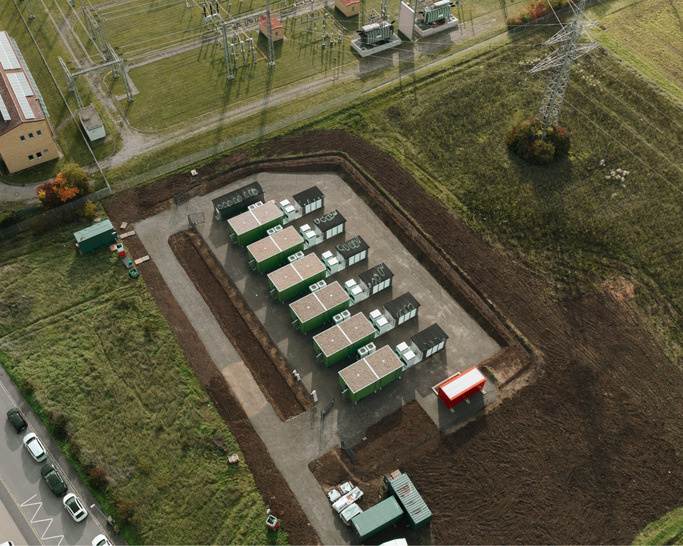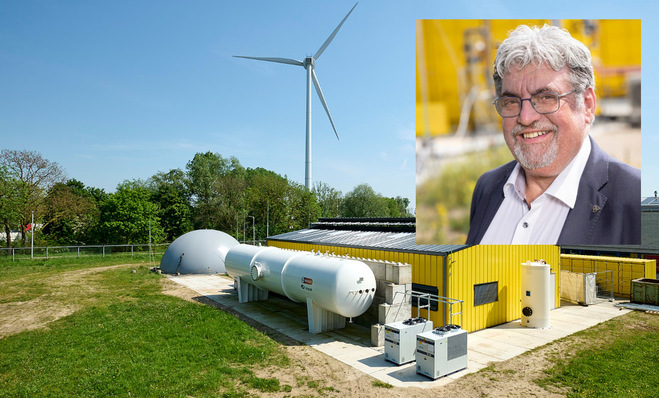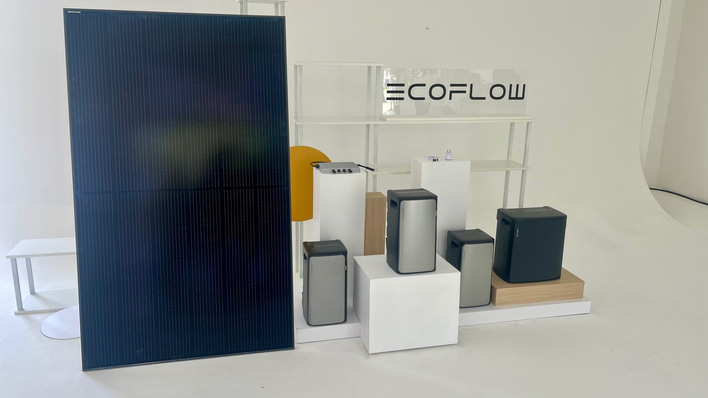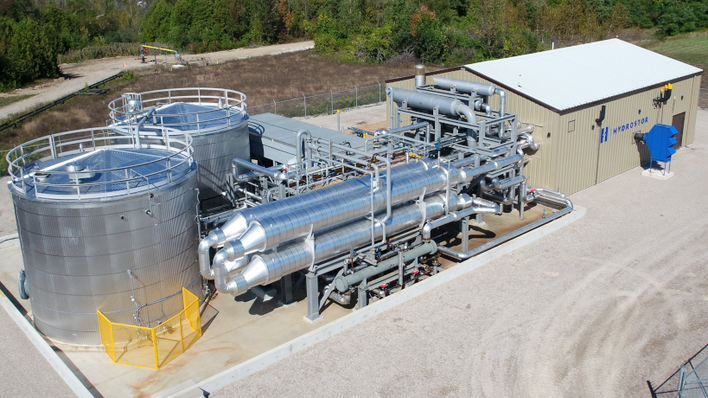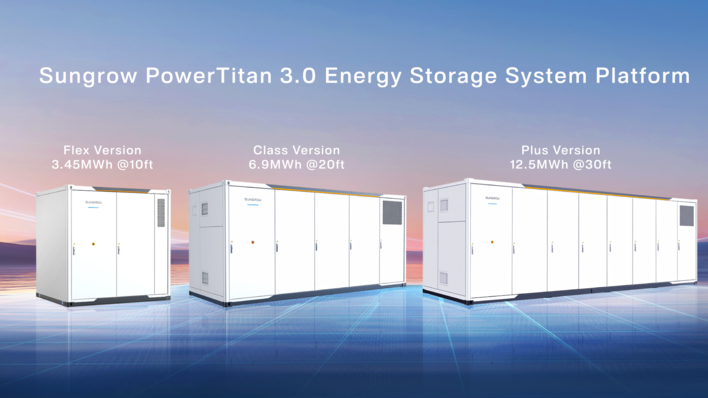Mr. Antwerpen, what role can large-scale battery storage play in the energy transition in Germany?
Large-scale battery storage is indispensable for the energy transition in Germany. The expansion of renewable energies means that the power supply is becoming more volatile. This in turn leads to increasing asynchrony in the demand and generation of energy. Fluctuations on the electricity markets, even overloads of the grids are the result. Large-scale battery storage systems counteract this: They compensate for volatilities, store surplus electricity and feed it into the grid at a later date in line with demand. They reduce bottlenecks and strong price fluctuations and also prevent renewable energies from being shut down - on the contrary, they can ensure that more PV and wind power plants are integrated into the holistic power supply and bring security as well as stability to a critical infrastructure. Large-scale battery storage systems thus make a decisive contribution to a successful energy transition in Germany.
To what extent is this potential already being exploited? How much large-scale battery storage capacity is currently installed in Germany?
The market for large-scale battery storage in Germany is very dynamic and we are seeing strong growth. However, the potential is far from exhausted. One of the reasons for this is that too little attention has been paid to large-scale battery storage in the past. Instead, the focus was on the expansion of renewable energies. How the volatile energy generated can and should be stored was not considered. This makes it all the more important that the topic of storage is gaining in importance - not least because of the current energy crisis.
Currently, a storage capacity of about 1.1 GW is installed in Germany. However, Fraunhofer ISE forecasts a storage demand of 104 GWh in 2030, and even 180 GWh in 2045, and assumes that the majority of this (approx. 45%) can be provided by large-scale battery storage. This clearly shows Germany is still in its infancy and the urgent potential is there to move forward faster.
Where are there still hurdles for the deployment of grid-stabilizing large-scale battery storage in Germany?
The large-scale battery storage market in Germany faces some regulatory challenges. For example, a so-called construction cost subsidy (BKZ) is levied for the construction of plants - an enormous sum that puts many construction projects at risk. Yet the levy is not justified. Large-scale battery storage facilities are only built at high-performance network nodes in consultation with the network operators. They relieve the strain on the grids and do not place an additional burden on them. Although §118 of the Energy Industry Act (EnWG) has created an exemption, it still offers too much room for interpretation, which is why the BKZ is still levied.
Did you miss that? These are the finalists for the ees AWARD 2023
On the other hand, market-based redispatch is also a hurdle. Large-scale battery storage is not yet meaningfully included here. Although German grid operators recognize the technical possibilities of storage, they do not use the flexibility it provides. They refrain from using storage resources due to uncertainties in redispatch costing and procedural challenges. In addition, regulators do not adequately consider the ability of storage to provide dispatch profiles that serve the grid. Battery storage is often seen as an additional load on the grid and, as a result, is still not being deployed in the most useful locations for congestion avoidance.
What about economic viability?
Large-scale battery storage can clearly be operated economically. At Kyon Energy, we rely on a multi-use strategy. This means that the storage facilities enable a rapid response to changing market conditions and requirements through different operating modes - which can also be run in parallel. This high degree of flexibility ensures that large-scale battery storage systems can always be used efficiently.
How do you assess the use of second-life batteries from e-cars for large-scale battery storage? Is this an important trend?
Unfortunately, building large stationary battery storage facilities with second-life batteries is currently not attractive, as the overall costs are higher than for new batteries and the efficiencies are significantly worse. Battery storage projects, as an important energy infrastructure, need to be implemented as cost-effectively as possible to keep energy prices low in the long term.
For one thing, the capital cost of second-life batteries is higher than one would expect: Batteries must be removed from vehicles and then tested. For a sensible interconnection of aged batteries, it is important to accurately determine the SoH (State of Health). If the batteries are subsequently interconnected to form new racks, additional installation work is required: Suitable enclosures must be found, often the battery management software is not publicly available, and the battery cooling system is not designed for stationary use. These factors melt away much of the cost savings of buying second-life batteries.

Kyon Energy
Second, the operating costs of second-life storage are higher: they have a higher internal resistance - this leads to more losses during charging and discharging, and the batteries have significantly poorer efficiencies. At the same time, the need for air conditioning increases significantly. As a result, old batteries need to be serviced more often and the risk of failure increases.
Last but not least, new batteries usually have a manufacturer's warranty of 15 years. This makes financing with banks much easier and reduces financing costs.
I think recycling old batteries and producing new batteries from the recovered materials is more attractive for storage facilities. For this, recycling methods need to be further improved.
How has your large battery storage business developed? Who are your most important customers?
We are experiencing strong growth. In 2022, we were involved in building 120 MW, which is about 20 percent of the total additions this year, and we currently have a concrete project pipeline of over 2 GWh. Key customers include investors in the energy sector - particularly large utilities and renewable energy investment funds.
The EU is committed to increasing the resilience of energy supply and supply chains and promoting battery production in Europe. Should more happen here and how?
Renewable and cost-effective mobility and energy supply is inconceivable without batteries. So far, Europe has hardly any production facilities for battery cells and modules and is therefore massively dependent on imports from other countries. A large part of the global production capacity for batteries is located in China. However, China itself is pursuing ambitious expansion targets for renewable energies and, accordingly, also for stationary battery storage systems. The energy transition in Europe would come to a standstill if China were to prioritize its own market and curb exports.
Also interesting: BESS: worth the hype?
Therefore, factories for the production of batteries must also be built in Germany and Europe. All investments here are extremely beneficial. The U.S., for example, is massively promoting the development of battery technologies and the construction of production facilities. Europe needs to catch up quickly to avoid losing out in one of the most important markets of the next decades. We must not forget that all other sectors for the production of goods depend on a cheap and secure energy supply!
The interview was conducted by Hans-Christoph Neidlein


